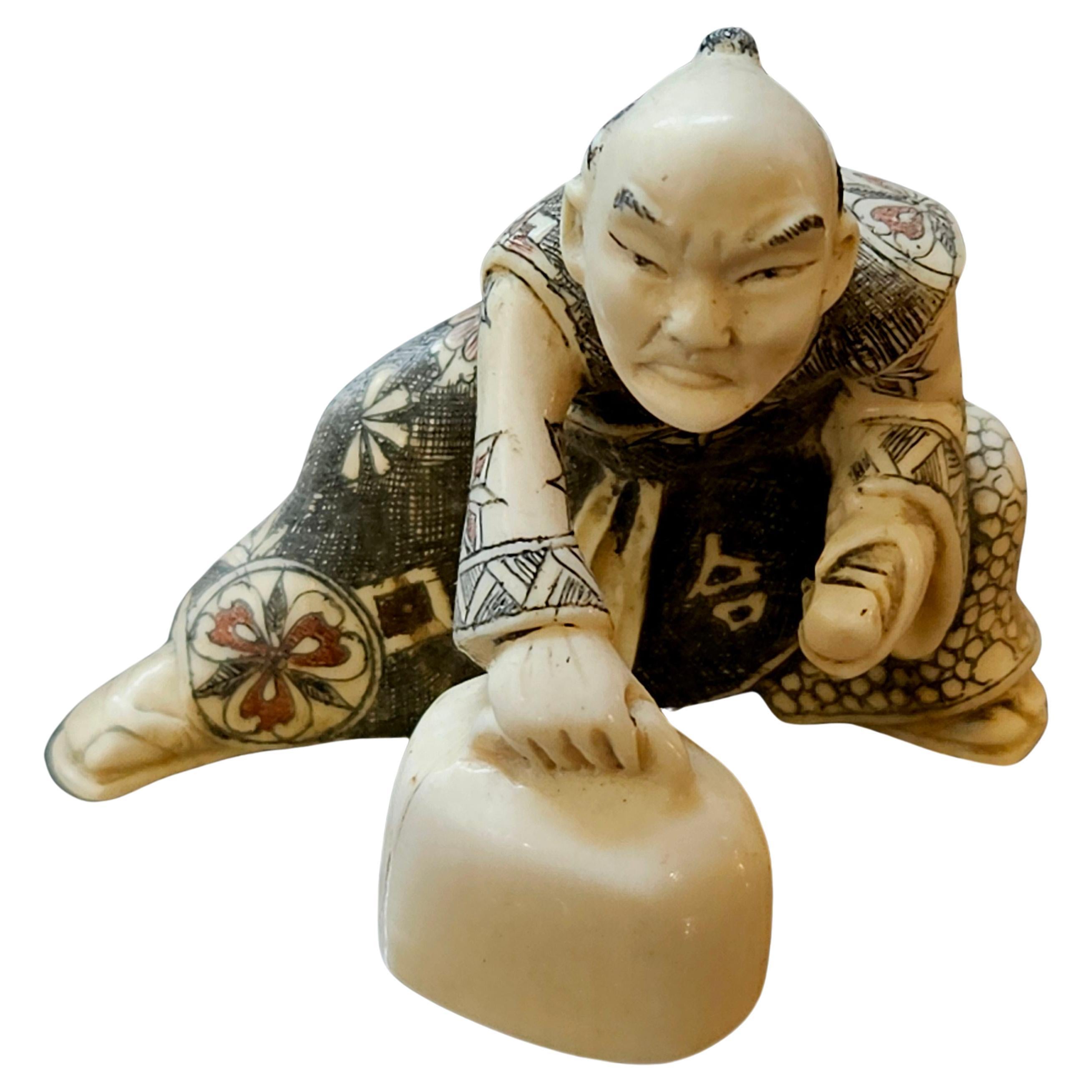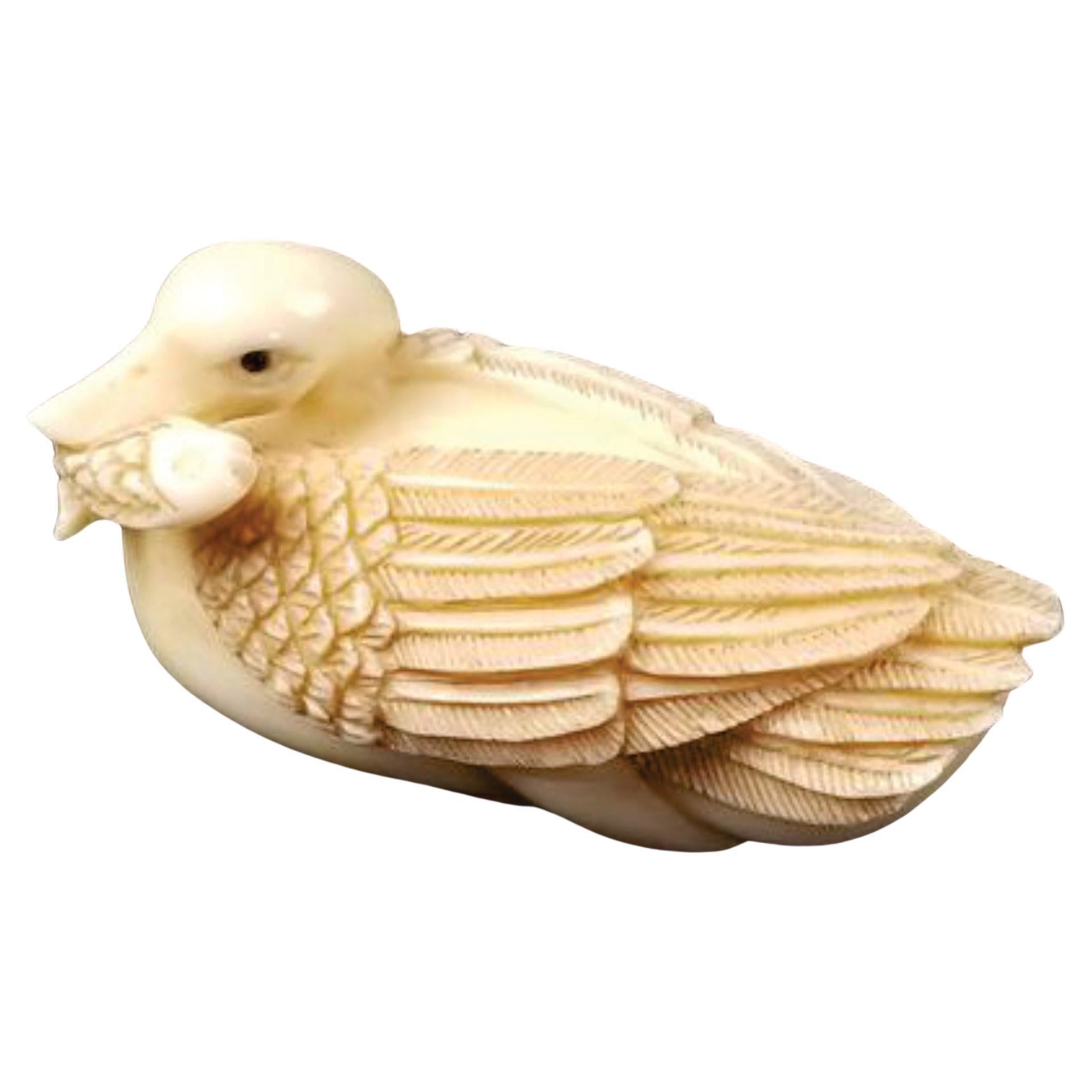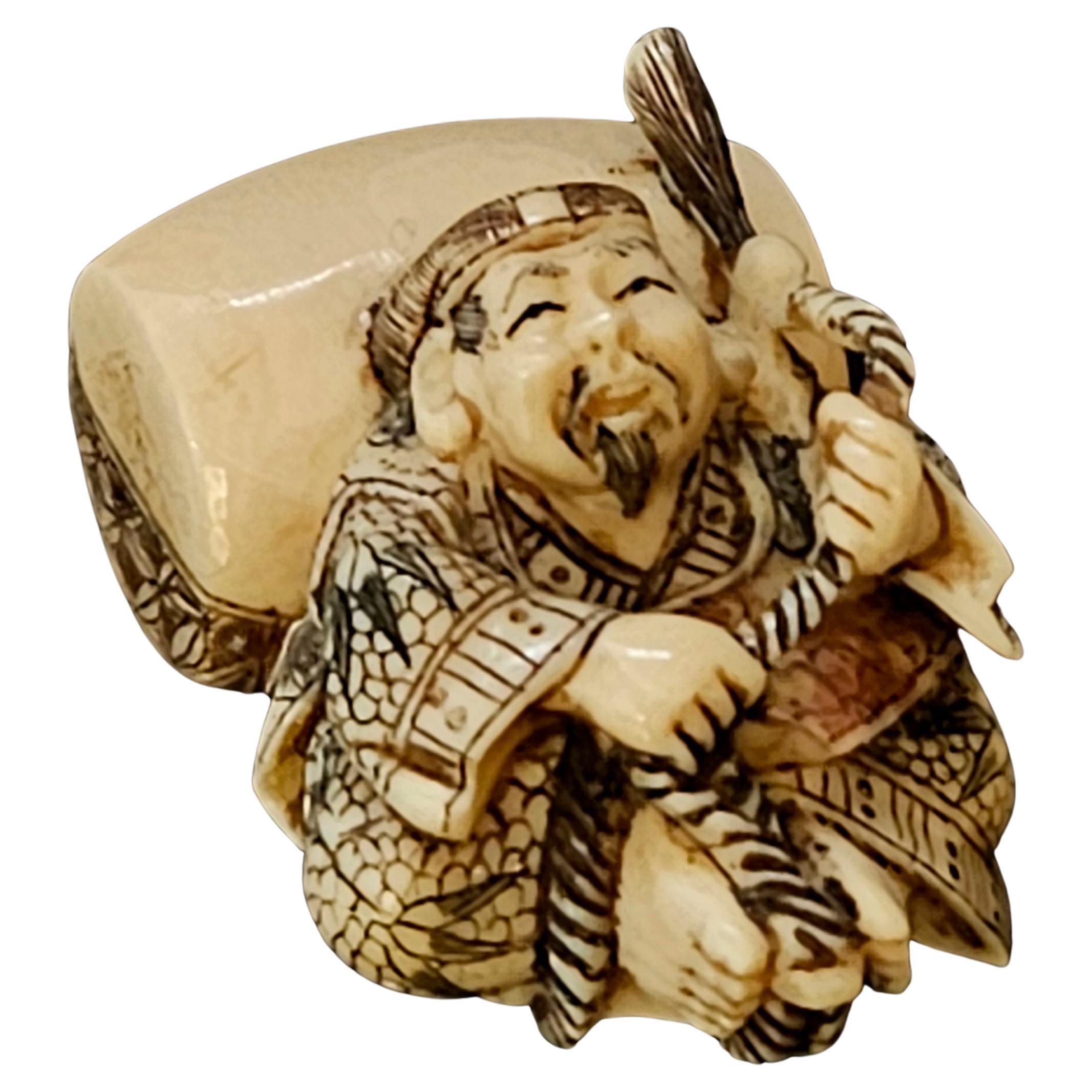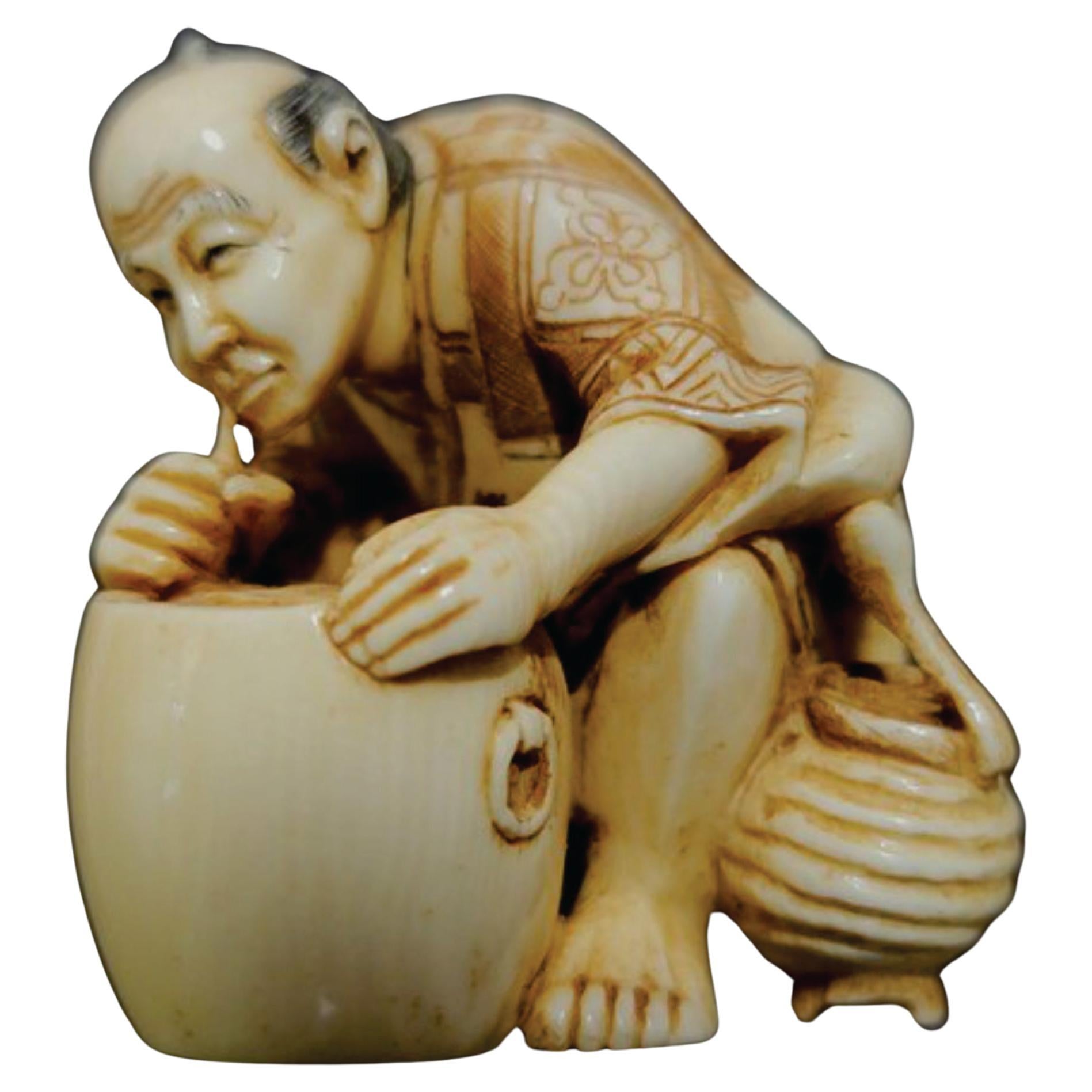Items Similar to Antique Pair of Japanese Carved Netsukes "Two Roosters", SIgned, Meiji Period
Video Loading
Want more images or videos?
Request additional images or videos from the seller
1 of 16
Antique Pair of Japanese Carved Netsukes "Two Roosters", SIgned, Meiji Period
About the Item
Antique Pair of Japanese Carved Netsukes "Roosterss", depicting two seating Roosters with a very fine detailed carving, signed on the bottoms.
This item is 1.5" wide x 1.5" deep x 0.875" high in dimension, from the late 19th century, a pair of wonderful art work.
The items are in excellent condition with no damages.
Shipping Note: USA only, no International shipping
The Essence of Netsuke:
Like all art objects of great worth, netsuke distills the essence of a specific time and place. Worn as part of a traditional Japanese man’s ensemble from the 17th century onwards, the netsuke’s purpose was hyper-specific, and its functional simplicity lent artists unlimited freedom to constantly redefine what it could be.
Formally, netsukes have few requirements: they must be small, they must have holes through which to pass a single cord, and they must have no protuberances that could damage one’s kimono. Everything else is left to the carver’s imagination. As such netsuke differs in style, subject, and material as widely as the personalities of their makers, and they are consequently supremely collectible.
Netsuke emerged as a practical solution to dressing in 17th-century Japan. ‘Men’s kimonos didn’t have sewn-up sleeves — they were completely open, front and back, and that meant that the sleeves couldn’t be used as a pocket, as they could in women’s kimonos,’ Goodall explains. To carry things such as tobacco, medicine, or other necessities, men hung stylish inro and other vessels from cords looped under and behind the wide sashes that held their kimonos in place. At the other end of those cords, men fastened small, ornamental objects as counterweights; those objects evolved into netsuke.
The netsuke’s origins are still ‘theoretical’, Goodall says. ‘It’s thought that, with increasing imports from China in the late 17th and early 18th centuries, the toggles that were used on Chinese clothing were imported,’ she explains. Those toggles may have spawned the netsuke.
But the netsuke we know today is a distinctly Japanese art form. ‘As the form developed, and as the netsuke carvers began to compete to come up with new and different ways of handling netsuke, then it became a localized art form that did not relate to anything in China,’ Goodall says. ‘It had completed its evolution by the 19th century.’
Much like jewelry, watches, and handbags today, netsuke were worn to match different occasions and ensembles. Japanese men who could afford them amassed netsuke to diversify their wardrobes.
Still, as Japanese fashion became more influenced by the West, netsuke disappeared from everyday use. Westerners took up the collector’s mantle. ‘In the Meiji period, right after Japan opened to the West in 1854, Americans and Europeans discovered netsuke and immediately started collecting them,’ Goodall says. ‘Westerners were so intrigued by netsuke that carvers continued to make a living by selling them to Westerners.’
- Dimensions:Height: 1.5 in (3.81 cm)Width: 1.5 in (3.81 cm)Depth: 0.875 in (2.23 cm)
- Sold As:Set of 2
- Materials and Techniques:
- Place of Origin:
- Period:
- Date of Manufacture:19th Century
- Condition:Wear consistent with age and use. Wear consistent with age and use.
- Seller Location:Norton, MA
- Reference Number:1stDibs: LU5848239596152
About the Seller
5.0
Platinum Seller
These expertly vetted sellers are 1stDibs' most experienced sellers and are rated highest by our customers.
Established in 2000
1stDibs seller since 2021
86 sales on 1stDibs
Typical response time: <1 hour
- ShippingRetrieving quote...Ships From: Norton, MA
- Return PolicyA return for this item may be initiated within 3 days of delivery.
More From This SellerView All
- Antique Pair of Japanese Carved Netsukes "Dragon Turtles", Meiji PeriodLocated in Norton, MAAntique Pair of Japanese Carved Netsukes "Dragon Turtles", depicting two turtles with turtle bodies but dragon heads. This item is 1.35" wide x 1.75" deep x 1" high in dimension, fr...Category
Antique 19th Century Japanese Decorative Boxes
MaterialsIvory, Paint
- Japanese Carved Netsuke Polychrome Decorated Figure, Signed, Meiji PeriodLocated in Norton, MANetsuke Japanese Hand-Carved Polychrome Decorated Figure, Signed on the bottom from the Meiji period. A truly hand-carved ivory figure, A man is lifting a weight. It looks like he ...Category
Antique 19th Century Japanese Decorative Boxes
MaterialsIvory, Paint
- Japanese Carved Netsuke Polychrome Figure "Sumo" Signed, Meiji PeriodLocated in Norton, MANetsuke Japanese Hand-Carved Polychrome Decorated Figure "Sumo", depicting a strongman holding a big rope and pulling something, signed on the bottom from the Meiji period. This it...Category
Antique 19th Century Japanese Decorative Boxes
MaterialsIvory, Paint
- Japanese Carved Netsuke Polychrome Figure Group Signed , MeijiLocated in Norton, MANetsuke Japanese Hand-Carved Polychrome Figure Group depicts a man holding a large cudgel and twing around a big bell, Signed on the bottom from the Edo period (1603~1868). A truly ...Category
Antique 19th Century Japanese Decorative Boxes
MaterialsIvory, Paint
- Japanese Carved Netsuke Polychrome Decorated Figur, Signed by Matsuyoshi, MeijiLocated in Norton, MANetsuke Japanese Hand-Carved Polychrome Decorated Figure, Signed by Matsuyoshi, from the Meiji period. Ric.NA003 A truly hand-carved mixed material figure, A Wise Man Holding a Rope,...Category
Antique 19th Century Japanese Decorative Boxes
MaterialsIvory, Paint
- Japanese Carved Netsuke Polychrome Decorated Figure, Signed by Yoshitomo, MeijiLocated in Norton, MANetsuke Japanese Hand-Carved Polychrome Decorated Figure, Signed by Yoshitomo from the Meiji period. Ric.NA004 A truly hand-carved ivory figure, An old man holding a straw and soaki...Category
Antique 19th Century Japanese Decorative Boxes
MaterialsIvory, Paint
You May Also Like
- Antique Japanese Cloisonné Meiji Enamel Box with RoostersLocated in New York, NYAn antique Japanese Meiji era covered enamel over brass trinket or jewelry box. Circa: late 19th century to early 20th century. The ware is enameled with a polychrome image of a roos...Category
Early 20th Century Japanese Meiji Decorative Boxes
MaterialsBrass, Enamel
- Japanese Meiji Period Silver Box Signed MasayukiLocated in Newark, EnglandJapanese Meiji period silver box with shibuichi plaque dating circa 1900. The box of rectangular form with a silver polished case stamped Jungin (J...Category
Antique Early 1900s Meiji Metalwork
MaterialsSilver
- Antique Japanese Meiji Period Lacquered Box w/ Original CaseLocated in New York, NYA wooden lacquered box with gold details dating from Japan's Meiji period. The piece comes complete with its original outer storage box. 9822Category
20th Century Japanese Boxes
MaterialsWood
- Antique Student Pencil Box Japanese Lacquer Ware Writing Meiji Period JapanLocated in Amsterdam, Noord HollandA Japanese lacquer writing box 19th Century Of rectangular shape, overall painted in gold with a faboulas landscape scene on a brown lacquer ground, the interior in black. Additiona...Category
Antique 19th Century Japanese Decorative Boxes
MaterialsLacquer
- Signed Japanese White Lacquer and Maki-E Lacquer Tansu, Meiji PeriodLocated in Ottawa, OntarioThe case decorated overall in crackle-glaze white lacquer and fitted with a patinated metal carrying handle over three tiers of small drawers. The first two tiers are comprised of a ...Category
Antique Late 19th Century Japanese Meiji Lacquer
MaterialsLacquer
- Large Japanese Cloisonne Enamel Goldstone Meiji Box with RoostersLocated in New York, NYA large antique Japanese Meiji Era covered enamel over brass trinket or jewelry box. The ware is adorned with polychrome floral, and foliage patterns made in the Cloisonne technique....Category
Early 20th Century Japanese Meiji Decorative Boxes
MaterialsBrass, Enamel
Recently Viewed
View AllMore Ways To Browse
Chinese Ivory Carving
Pair Emerges
Pair Of Constant
Rooster Signed
Hand Painted Japan Fine China
Antique Ivory Netsukes
Pair Of Ornamental
Antique Painted Box American
Antique Japanese Kimono Art
Antique American Wardrobe
Mens Pocket Watch Antique
Man Antique Pocket Watch
Antique Medicine Box
Japanese Ivory Netsukes
Chinese Clothing 18th Century
Antique West End Watch
Chinese Netsuke
Mens Jewelry Boxes





